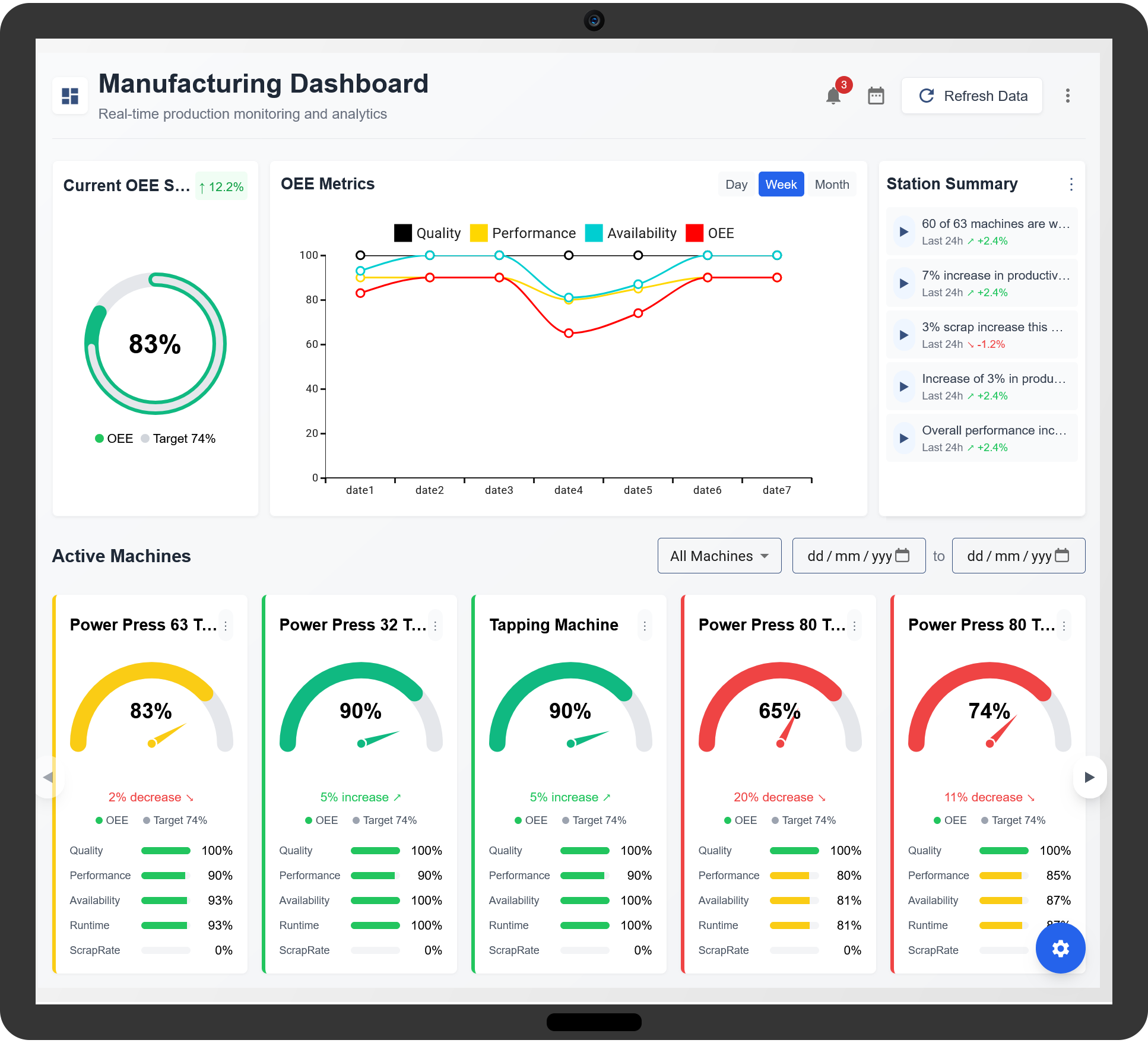Overall Equipment Effectiveness (OEE) software is a powerful tool that helps manufacturers optimize machine performance, reduce downtime, and enhance productivity. Advanced OEE software goes beyond basic efficiency tracking by integrating real-time analytics, predictive maintenance, and automated reporting. These features enable manufacturers to make data-driven decisions and improve operational efficiency.

1. Real-Time Performance Monitoring
Advanced OEE software provides real-time monitoring of production lines, allowing manufacturers to track machine availability, performance, and quality. This feature ensures that any deviations from optimal conditions are immediately detected, enabling quick corrective actions.
- Live Dashboards: Displays key metrics in an easy-to-understand format.
- Automated Alerts: Sends notifications when equipment efficiency drops.
- Customizable KPIs: Allows users to define key performance indicators for specific production needs.
2. Automated Data Collection
Traditional OEE tracking relies on manual data entry, which can lead to errors and inefficiencies. Advanced OEE software automates data collection from sensors, PLCs, and IoT devices to provide accurate and real-time insights.
- Machine Integration: Connects directly to manufacturing equipment for seamless data flow.
- Reduction in Human Error: Eliminates inconsistencies caused by manual input.
- Instant Data Processing: Ensures that reports and dashboards reflect real-time conditions.
3. Predictive Maintenance
One of the most valuable advanced features of OEE software is predictive maintenance. By analyzing historical data and equipment usage patterns, the system can forecast potential failures before they occur.
- Condition-Based Monitoring: Tracks equipment health based on real-time data.
- Failure Predictions: Identifies patterns that indicate potential breakdowns.
- Maintenance Scheduling: Automatically generates maintenance tasks based on predictive insights.
4. How to Use OEE Software for Root Cause Analysis
Root cause analysis (RCA) is a crucial process in manufacturing that helps identify the underlying reasons for production inefficiencies. Advanced OEE software provides powerful tools to streamline RCA and implement effective solutions.
Step 1: Collect Data on Performance Issues
Use the OEE software to gather detailed data on machine downtime, slow cycles, and quality defects. Ensure that all anomalies are recorded for analysis.
Step 2: Identify Patterns and Trends
Analyze historical data to detect recurring problems. Use automated reporting features to visualize trends and identify common causes of inefficiencies.
Step 3: Utilize Automated Root Cause Detection
Many advanced OEE systems include machine learning algorithms that suggest potential causes based on data patterns. This reduces the time needed to identify problems.
Step 4: Implement Corrective Actions
Once the root cause is determined, use the OEE software to track corrective actions. Set up automated alerts to monitor the effectiveness of implemented solutions.
Step 5: Continuous Improvement
Use OEE analytics to measure the impact of corrective actions and refine processes over time. Regularly review performance data to sustain efficiency improvements.
5. Customizable Reports and Data Visualization
Advanced OEE software provides a range of reporting and visualization options that help manufacturers make informed decisions.
- Custom Reports: Allows users to generate tailored performance reports.
- Interactive Charts: Provides visual representations of efficiency metrics.
- Historical Analysis: Tracks progress over time and identifies long-term trends.
6. Cloud-Based OEE Solutions
Cloud integration enables remote access to OEE data, allowing managers to monitor production performance from anywhere. This feature enhances collaboration and decision-making across multiple locations.
- Remote Monitoring: Enables access to real-time data from any device.
- Centralized Data Storage: Ensures consistency across multiple production sites.
- Scalability: Easily adapts to growing manufacturing operations.
7. Integration with Other Manufacturing Systems
To maximize efficiency, advanced OEE software can integrate with other enterprise systems such as ERP, MES, and CMMS.
- ERP Integration: Aligns production data with business planning and financial reports.
- MES Connectivity: Provides detailed insights into shop floor operations.
- CMMS Linkage: Enhances maintenance planning based on real-time machine performance.
Advanced features of OEE software
What are the advanced features of OEE software?
Advanced OEE software includes real-time monitoring, predictive maintenance, automated alerts, machine learning insights, and integration with other manufacturing systems.
How does real-time data monitoring enhance OEE software?
Real-time data monitoring enables manufacturers to track machine performance instantly, identify bottlenecks, and make data-driven decisions for process optimization.
What role does predictive maintenance play in OEE software?
Predictive maintenance uses machine learning and historical data to predict potential failures, reducing unplanned downtime and optimizing maintenance schedules.
How does OEE software support downtime tracking?
OEE software tracks machine downtime by recording causes, duration, and frequency, helping manufacturers reduce interruptions and improve productivity.
What types of analytics are available in OEE software?
OEE software offers performance analytics, trend analysis, root cause detection, and predictive insights to help manufacturers improve efficiency.
How does OEE software integrate with other manufacturing systems?
OEE software integrates with ERP, MES, and SCADA systems, ensuring seamless data exchange for a comprehensive view of manufacturing operations.
What are automated alerts in OEE software?
Automated alerts notify operators and managers about critical issues like machine downtime, quality deviations, and performance drops in real time.
How does OEE software assist in root cause analysis?
OEE software analyzes historical data to identify the primary causes of inefficiencies, helping manufacturers implement corrective actions.
What is the role of machine learning in OEE software?
Machine learning in OEE software helps detect patterns, predict failures, and recommend process improvements based on data trends.
How does OEE software help in production scheduling?
OEE software optimizes production scheduling by providing accurate data on machine availability, performance, and efficiency.
What are customizable dashboards in OEE software?
Customizable dashboards allow users to display key OEE metrics, trends, and reports based on specific business needs.
How does OEE software support multi-site manufacturing?
OEE software enables centralized monitoring and comparison of performance metrics across multiple manufacturing sites.
What role does cloud-based access play in OEE software?
Cloud-based OEE software allows remote access to performance data, enabling real-time monitoring from any location.
How does OEE software enhance compliance and reporting?
OEE software automates compliance tracking and generates reports for audits, ensuring adherence to industry regulations.
What are the benefits of using advanced OEE software?
Advanced OEE software improves efficiency, reduces downtime, enhances quality control, and supports data-driven decision-making.